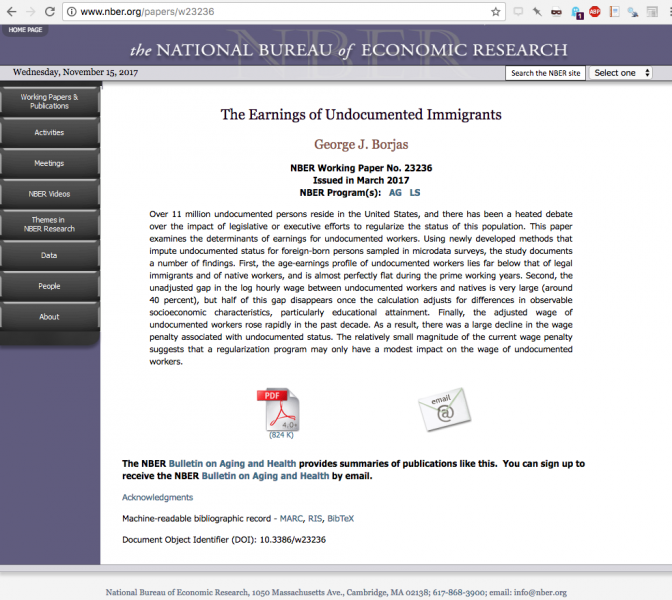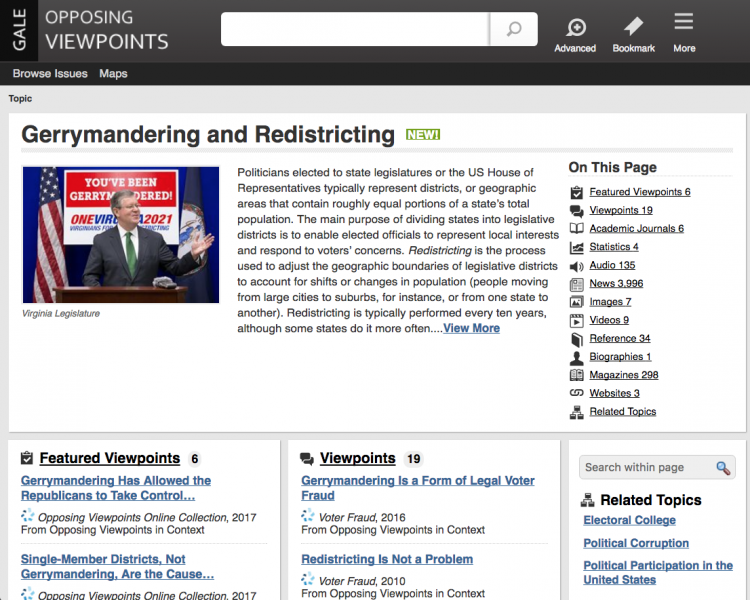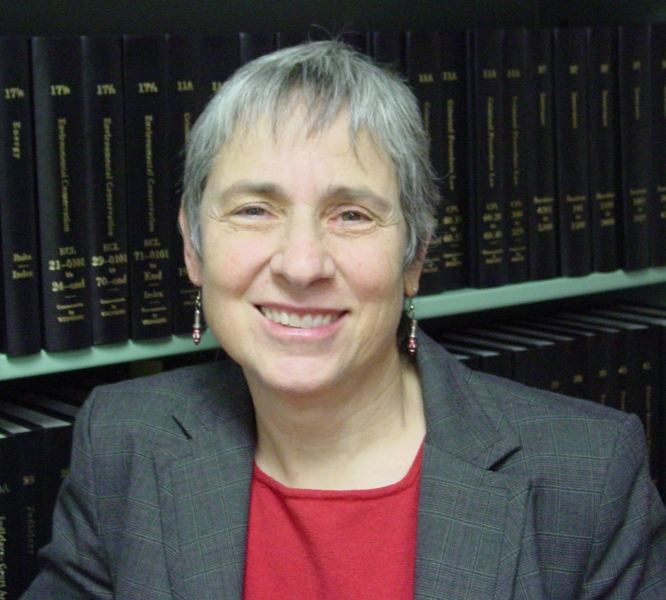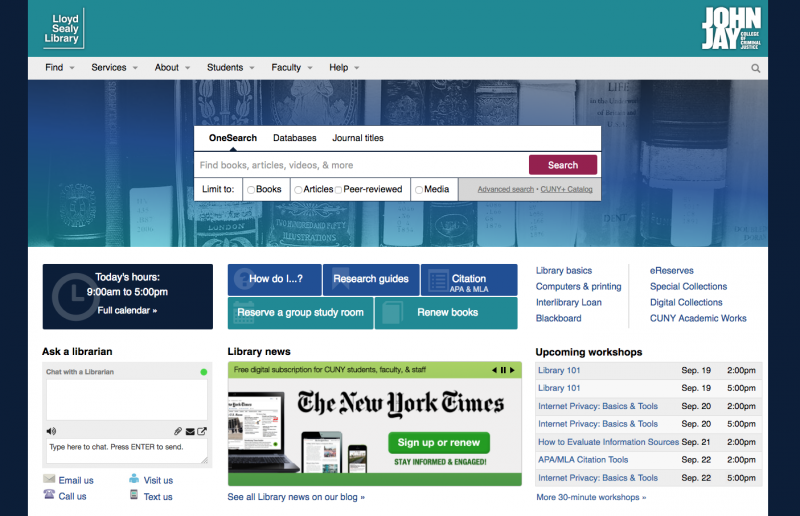Interview by Kathleen Collins

Photo: Bonnie shows off a gift at her travel-themed retirement party.
This interview was published as Bonnie Nelson, Associate Librarian for Information Systems, retires.
In 1980, John Jay’s president, Gerald Lynch, needed information about the potential for corruption in casino gambling in New York. Chief Librarian Eileen Rowland excitedly told him about a wonderful new way of searching literature, and she tasked her newest librarian, Bonnie Nelson, with helping the president with his research. Lynch visited the library, still wearing running shorts from his morning workout, and sat with Bonnie as she used an acoustic coupler with a dedicated “dumb” (unconnected computer) terminal, dialed a phone number, got a tone and put the handset in the cradle attached to the terminal so the terminal could communicate with the mainframe located in some faraway location. All that before she could even begin a (very slow, 300 bytes/second) search using precise Boolean language and controlled subject headings in Dialog, just to come up with a list of bibliographic references (maybe abstracts if she was lucky) to print out and then locate on the library shelves or on microfilm (if she was luckier).

It sounds cumbersome and archaic now, but Bonnie was at the forefront of library technology. As a Bronx High School of Science student, she had taken take a class in computer programming. That minimal knowledge marked her as a semi-expert, allowing her to get hired as a librarian at NYU where they were implementing a new computerized circulation system. “It was tough times in 1973,” says Bonnie. “Nobody was hiring. They were firing. I was lucky to be hired at all, anywhere.” She played an important role in getting that new system underway and also did reference (of the mediated type described above). She stayed for almost seven years, and was the first librarian to come up for tenure as they had just been granted faculty status. “[NYU] decided everyone needed a PhD,” says Bonnie of the tenure requirements. “And should have written a book or something. I was the test case. I was pretty young and they didn’t want to make a commitment to someone so young.” But more to her credit, she revealed a trait that would serve her well later on: “I didn’t know enough to keep my mouth shut at faculty meetings.” Combined with the overly stringent requirements and an austere economy, the stars were not aligned for Bonnie to remain at NYU, and she was not granted tenure. “It was a rich person’s university,” says Bonnie, admitting that she had not been completely comfortable there. NYU’s loss was CUNY’s gain, where she clearly found her niche and remained for the rest of her library career.
It was fitting, too, as Bonnie started her academic life at City College where she had been a college student and where she had experienced the tumult of the transition to another new era. In the late 1960s and early 1970s, campuses all around the U.S. were frequently closed due to antiwar activity. Bonnie recalls there being two or three years in a row when Spring finals were cancelled. “There were so many protests,” she says. “It was exciting and unnerving.” Adding to the revolutionary air at CCNY during the same time period were equally passionate protests about another issue. Bonnie was a freshman when more than 200 students (mostly black and Puerto Rican) chained the gates to the college in protest about admission standards. “City College was very elitist and white and you needed a 92 average to get in,” says Bonnie. “There we were, in in the middle of Harlem, a black area, with all these elite, white middle class kids.” Eventually, the Chancellor agreed to work towards open admissions which guaranteed every New York City high school graduate a place at City College. “It was the civil rights era,” says Bonnie. “There was a feeling that things needed to change.”
Sympathetic to the causes, Bonnie was easily caught up in the spirit of activism all around her. “It’s what everybody was doing,” she says. A year or two after the open admissions protest, New York State raised the minimum wage, but she was a student aide in the library, making even less than a college assistant, and CUNY was not required to pay student aides minimum wage. She was one of the co-organizers of a one-day strike in protest. A few months later, the aides received their deserved increased pay. Bonnie’s family was not particularly politically active, but in high school, she says, “I was mentored by a fellow student who was much more radical, and she educated me about what was really going on in Vietnam, and so I started tentatively taking steps towards demonstrating against the war. And then in college, I met my husband [Bob Nelson, later Deputy Director of Student Services at the Graduate Center] when I was a freshman, and he was pretty left wing, came from a left wing family, and he continued my education.” Her family eventually came around, too, “as the rest of the country did,” says Bonnie.
A self-described bookworm as a child, Bonnie frequented the public library in her northeastern Bronx neighborhood. “Though I never spoke to a librarian other than to get my library card,” she confesses. She actually had some librarian training before she started at City College. After high school, her mother enjoined her to do volunteer work, so Bonnie headed to Montefiore Medical Center thinking she might be interested in the medical field. On the way to her interview, she passed the patients’ library and spontaneously told the volunteer coordinator she wanted to work in the library, which she did for the summer. As a student at City College, she worked as a staff member in the library for four years. She was an anthropology major but not too keen on the idea of conducting fieldwork in exotic locations for the rest of her life, so she decided to go to library school after college. It was this unusually early start in the field that allowed her such a long library career.
During her time in the library science graduate program at Columbia University, she continued working at the City College library where she mostly did reference work. After library school, while working at NYU, she also obtained a second Master’s degree in Anthropology (starting at Hunter and finishing at NYU). “I didn’t expect to wind up at a criminal justice college,” says Bonnie. “I had no interest in it and knew nothing about it. I thought, well, it’s a job for a few years and we can pay the rent.” Her experience at NYU starting the new computerized circulation system was attractive to Chief Librarian Rowland at John Jay where they were also implementing a new system—using punch cards. “That was old technology even at the time,” says Bonnie, “and they were desperate to have someone who knew something about computers.” Like most faculty who come to John Jay with little background in criminal justice, Bonnie got interested quickly. She vividly recalls helping a forensic science student, who later went on to work for the medical examiner, do research on blood spatters. “And I helped someone in fire science find out the temperature at which blood boils. They needed to know how hot was too hot for firefighters to go in before blood could no longer deliver the oxygen. There were these very gross searches, and I thought, wow, working at John Jay, this is really different!” She also began to stay abreast of crime stories in the news since she knew she would be asked about such subjects at the Reference Desk.
After nearly four decades here, Bonnie is well known for her active role in PSC-CUNY. But despite her early days in activism at City College, she was not a union crusader right away. For her first few years, her time was occupied by trying to publish and get tenure. Junior library faculty at that time got no automatic reassigned time but were eligible to apply for special two week reassignments for research. After being granted tenure, she had her daughter, Miranda. Jim Cohen, Public Management faculty (now emeritus) and chapter chair, asked if she wanted to be more involved in the union, and she said, “Ask me again when my daughter is more independent.” A few years later he did. She served as an alternate delegate and was then tapped to be secretary. “I was very good at taking notes,” she says, and she discovered that distributing notes of Labor-Management and Chapter meetings was actually critical to helping colleagues engage with the union. She also spent years on the PSC Delegate Assembly Library Faculty Committee. “Working with the union and librarians in the union and helping the union to understand librarians are just like other faculty but a little bit different,” she says. She was “in the troops” with other faculty librarians to advocate and win the two additional weeks of annual leave for librarians in the most recent contract, bringing library faculty closer to the parity they have long sought.
One of the things I’m most proud of is the work I did here, and CUNY-wide, in keeping the enemies of academic freedom at bay.
In addition, and even more meaningful for Bonnie, was her work related to technology and academic freedom. She was on the John Jay Faculty Senate Technology Committee, serving as co-chair from 1996 to 2017. In 2005, Bonnie was appointed by the University Faculty Senate to the CUNY IT Steering Committee, a body comprised mostly of vice presidents, or as Bonnie describes, “people who were authorized to make decisions on behalf of their colleges … The UFS needed someone knowledgeable about technology and willing to go to meetings.” In both groups, for about a dozen years, she says, the faculty felt very much under attack with regard to their use of technology. “When the web became a big thing,” says Bonnie, “there were attempts to censor what faculty were seeing and what they could search for. They were keeping logs of every site that faculty went to. Some colleges in CUNY put software on computers in libraries so you couldn’t freely search, but we fought that off at John Jay. [The administration] wouldn’t promise that they wouldn’t use the logs to track what people were doing, and at John Jay, we felt it was a great attack on academic freedom, particularly at a place where faculty were researching terrorist organizations, murder, pedophiles, sex crimes, things like that. There were big fights over whether the college could or should do this [monitoring]. The Faculty Senate Technology Committee was right in the forefront of that.” After 9/11, the FBI began visiting libraries—including John Jay’s—and demanding records of Internet use to identify suspicious activity. “We always fought that [keeping track of use of individual computers] because we wanted the students and faculty to be able to be anonymous,” says Bonnie. “So one of the things I’m most proud of is the work I did here and CUNY-wide, in keeping the enemies of academic freedom at bay.”
She and her colleagues were successful at John Jay in that regard. “We won here and were able to get the support of the important people and came to good resolutions,” she says. “But CUNY was more difficult. I kept very good notes of what was going on at the IT Steering Committee and I tried to alert the chair of the UFS to what was going on. And I used to send my notes to the chair of the UFS where they printed and distributed them. The IT Steering Committee was not a governance body. It was not in the charter anywhere, but it was making these very important decisions. They decided they would have this one faculty representative, and that was me. I could try and speak up for the faculty and occasionally they would listen but more often what happened was the UFS would take alarm, appropriately, and try to pressure the chancellor or various people. Finally they fired me off the UFS. I was a pain.”
In the decades spanning Bonnie’s CUNY career, the most obvious change has been the growth of technology and the Internet. “I used to be the only person I knew who used email,” she says. In 1984, John Jay won a Department of Education grant that included IBM microcomputers, and Bonnie was charged with administering the grant. “In December, we got this big delivery of twenty microcomputers, and they were really expensive and they were put in this room that was going to be the computer lab, but it didn’t have a lock yet and security didn’t have enough staff to protect the machines. So I spent New Year’s Eve sitting in a room with a bunch of microcomputers, guarding them.” That was the first student computer lab at the college. Very few faculty had computers in their offices. “Most faculty didn’t know how to use them, so one of the things the library did was teach faculty how to do word processing, introduction to email, and when the World Wide Web came along we showed them how to search.” She recalls that she and Kathy Killoran (a librarian at John Jay from 1990 to 2006, now Executive Academic Director in Undergraduate Studies) set up what was either the first or second CUNY library connection to the Internet. “We did it ourselves,” she says. “We got the equipment, ran a few wires, plugged it in and there we were. We were very proud of ourselves.”
At John Jay, we have probably the best relations with the college IT department of any CUNY school.
Bonnie considers building the Library’s IT infrastructure—both equipment and personnel—to be her most important contribution to the library. With the support of all three of the chief librarians with whom she worked, she made sure the library controlled its own equipment and content. After the then-head of the Microcomputer Lab tried to edit the library’s web page on the brand new John Jay College website, the Library developed one of the first library websites in CUNY. “We did it by hiring an NYU student who built us a webserver on an IBM desktop and wrote web pages in basic HTML,” Bonnie recalls. That interference by John Jay’s IT department was an aberration, however, and generally relations with DoIT have been constructive and mutually beneficial. “I’ve been lucky that throughout my time at John Jay key people in DoIT have understood that robust library IT infrastructure is critical to the academic success of both faculty and students,” says Bonnie. “We have probably the best relations with the college IT department of any CUNY school—based on years of building trust.” Bonnie said that this allowed her and her staff to build what was needed to provide access to remote library resources from on campus and off—for many years providing better service than was available almost anywhere else in CUNY. Following those early years of reliance on part-time student help and as IT became more complex, Bonnie increasingly turned over the technical aspects of the job to highly-skilled adjuncts and then to specially-educated HEOs (currently Geng Lin) and librarians (like Robin Davis) as she coordinated in her role as Associate Librarian for Information Systems.
One of her most salient memories from her early years at John Jay is a painful one. The Library (and the rest of the college) was located in North Hall, and her office was near the circulation desk. Late on a Friday afternoon in January 1985, Bonnie heard a thud and looked out to see Lloyd Sealy, a formerly high ranking NYPD officer and faculty member at John Jay, lying on his back. “He’d had a massive heart attack,” says Bonnie. She and another woman performed CPR, but he did not survive. It was his 68th birthday. Lloyd had always spent a lot of time in the Library, and students always knew they could find him there. Appropriately, he became the library’s namesake in a 1991 dedication ceremony.
In more recent years, Bonnie became interested in assessment and spent much of her time analyzing library data. “I liked playing with the statistics to see if I could make them tell some kind of story about how we were getting better or how we could do things better, and just looking at trends over time.” Reflecting on how the role of librarians has evolved over the course of her career, recognizing that there is a misperception that librarians are not as essential as they were back in the days of mediated searching, Bonnie says, “Students need a guiding hand. As with so much else in colleges they think they know things they don’t know. They think they know how to weigh what’s true and what’s not. We can see what happens in the country when people don’t know how to tell what’s objective reality and how to figure out what’s real and what’s fake or when they’re being snowed.” She believes that librarians are uniquely suited to try and help people understand where information comes from. “It’s getting worse because of technology,” she says. “It used to be if you saw something on paper you thought it was authoritative, and now if you see it on the computer screen you think it’s authoritative. And it’s so much easier to put anything up on a computer screen. Propaganda used to be expensive. You had to have a printing press. Now just about everybody can do it.”
While Bonnie says that she misses the people at John Jay, “It’s very nice not going to work.” Shortly before she retired, she talked about going camping with her husband, something she expressed some reticence about. They’ve gone twice in the last four months, and she and Bob (who retired in 2016) are planning a cross-country trip to visit national parks. Never one to take the easy path, Bonnie continues to challenge herself. “We survived. Camping is fun in a masochistic way.”
November 2017
More from the Fall 2017 newsletter »











